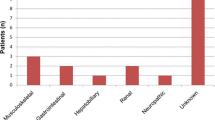Abstract
Objective
To evaluate the outcome of robotic-assisted laparoscopic pyeloplasty (RAP) in symptomatic patients with ureteropelvic junction obstruction (UPJO) versus patients who were incidentally found to have UPJO.
Methods
We retrospectively reviewed the records of 141 patients who underwent RAP at Massachusetts General Hospital between 2008 and 2020. Patients were categorized into symptomatic group and asymptomatic group. We compared patient demographics as well as preoperative and postoperative symptoms and functional renal scans.
Results
The study population included 108 patients in the symptomatic group and 33 patients in the asymptomatic group. Mean age was 46 ± 17 years with average follow-up time of 12 ± 18 months. Asymptomatic patients had significantly higher rate of definite obstruction (80% versus 70%) and equivocal obstruction (10% versus 0.9%) on preop renogram (P: 0.001). There was no significant difference in the preop split renal function in symptomatic versus asymptomatic group (39 ± 13 versus 36 ± 13 P: 0.3). Following RAP, 91% of symptomatic patients achieved symptom resolution, while four asymptomatic patients (12%) developed new symptoms postoperatively. Compared to preoperative renogram, RAP resulted in improvement in renogram indices in 61% of symptomatic versus 75% of asymptomatic patients (P: 0.2).
Conclusion
Although asymptomatic patients had worse obstructive indices on renogram, both symptomatic and asymptomatic groups had comparable improvement in renal function following robotic pyeloplasty. RAP is a safe and efficacious minimally invasive option to offer symptom resolution in symptomatic patients and improve obstruction in both symptomatic and asymptomatic patients with UPJO.


Similar content being viewed by others
Data availability
The data that support the findings of this study are available from the corresponding author, [DD], upon reasonable request.
References
Etafy M, Pick D, Said S et al (2011) Robotic pyeloplasty: the University of California-Irvine experience. J Urol 185(6):2196–2200. https://doi.org/10.1016/j.juro.2011.02.054
Stamm AW, Akapame S, Durfy S, Du CC, Kozlowski PM (2019) Outcomes after robotic-assisted pyeloplasty in patients presenting with pain versus nonpain presenting symptoms. Urology 03(125):111–117. https://doi.org/10.1016/j.urology.2018.10.046
Looney AT, Nason GJ, McGuire BB et al (2014) Incidentalology: a developing urological sub-specialty. Surgeon 12(6):301–306. https://doi.org/10.1016/j.surge.2013.08.004
Rasool S, Singh M, Jain S et al (2020) Comparison of open, laparoscopic and robot-assisted pyeloplasty for pelviureteric junction obstruction in adult patients. J Robot Surg 14(2):325–329. https://doi.org/10.1007/s11701-019-00991-6
Hanske J, Sanchez A, Schmid M et al (2015) Comparison of 30-day perioperative outcomes in adults undergoing open versus minimally invasive pyeloplasty for ureteropelvic junction obstruction: analysis of 593 patients in a prospective national database. World J Urol 33(12):2107–2113. https://doi.org/10.1007/s00345-015-1586-4
Light A, Karthikeyan S, Maruthan S, Elhage O, Danuser H, Dasgupta P (2018) Peri-operative outcomes and complications after laparoscopic vs robot-assisted dismembered pyeloplasty: a systematic review and meta-analysis. BJU Int 122(2):181–194
Foley FE (2002) A new plastic operation for stricture at the uretero-pelvic junction. Report of 20 operations 1937. J Urol 167(2 Pt 2):1075–1095 (discussion 1096)
Anderson JC, Hynes W (1949) Retrocaval ureter; a case diagnosed pre-operatively and treated successfully by a plastic operation. Br J Urol 21(3):209–214. https://doi.org/10.1111/j.1464-410x.1949.tb10773.x
Nordic Adhesion Prevention Study Group (1995) The efficacy of Interceed(TC7)* for prevention of reformation of postoperative adhesions on ovaries, fallopian tubes, and fimbriae in microsurgical operations for fertility: a multicenter study. Fertil Steril 63(4):709–714
Stamm AW, Akapame S, Durfy S, Kozlowski PM (2019) Robotic pyeloplasty in patients with equivocal diuretic renogram. Urology Pract 6(6):364–368
Jackman SV, Maganty A, Wolfson AB et al (2022) Resolution of hydronephrosis and pain to predict stone passage for patients with acute renal colic. Urology 01(159):48–52. https://doi.org/10.1016/j.urology.2021.09.017
Fontenot PA, Capoccia TR, Wilson B, Arthur A, Duchene DA (2016) Robotic-assisted laparoscopic pyeloplasty: analysis of symptomatic patients with equivocal renal scans. Urology 93:92–96. https://doi.org/10.1016/j.urology.2016.03.003
Popelin MB, Pinar U, Benamran D et al (2021) Functional outcomes after robot-assisted pyeloplasty for ureteropelvic junction obstruction: a bi-centre experience. Int J Med Robot 17(2):e2201. https://doi.org/10.1002/rcs.2201
Tobis S, Venigalla S, Balakumaran K et al (2013) Analysis of a large single-center experience with robot-assisted pyeloplasty. Int J Urol 20(2):230–234. https://doi.org/10.1111/j.1442-2042.2012.03119.x
Nishi M, Matsumoto K, Fujita T, Iwamura M (2016) Improvement in renal function and symptoms of patients treated with laparoscopic pyeloplasty for ureteropelvic junction obstruction with less than 20% split renal function. J Endourol 30(11):1214–1218. https://doi.org/10.1089/end.2016.0553
Hopf HL, Bahler CD, Sundaram CP (2016) Long-term outcomes of robot-assisted laparoscopic pyeloplasty for ureteropelvic junction obstruction. Urology 90:106–110. https://doi.org/10.1016/j.urology.2015.12.050
Lee D, Link RE (2014) Recurrent symptoms following pyeloplasty with a normal endoscopic evaluation: assessment and outcomes of a challenging patient cohort. Urology 84(1):227–231. https://doi.org/10.1016/j.urology.2014.03.010
Author information
Authors and Affiliations
Corresponding author
Additional information
Publisher's Note
Springer Nature remains neutral with regard to jurisdictional claims in published maps and institutional affiliations.
Rights and permissions
Springer Nature or its licensor (e.g. a society or other partner) holds exclusive rights to this article under a publishing agreement with the author(s) or other rightsholder(s); author self-archiving of the accepted manuscript version of this article is solely governed by the terms of such publishing agreement and applicable law.
About this article
Cite this article
Razavi, S., Babbin, J. & Dahl, D.M. Outcomes of robotic-assisted pyeloplasty in symptomatic versus asymptomatic patients. World J Urol 41, 1959–1965 (2023). https://doi.org/10.1007/s00345-023-04445-5
Received:
Accepted:
Published:
Issue Date:
DOI: https://doi.org/10.1007/s00345-023-04445-5




